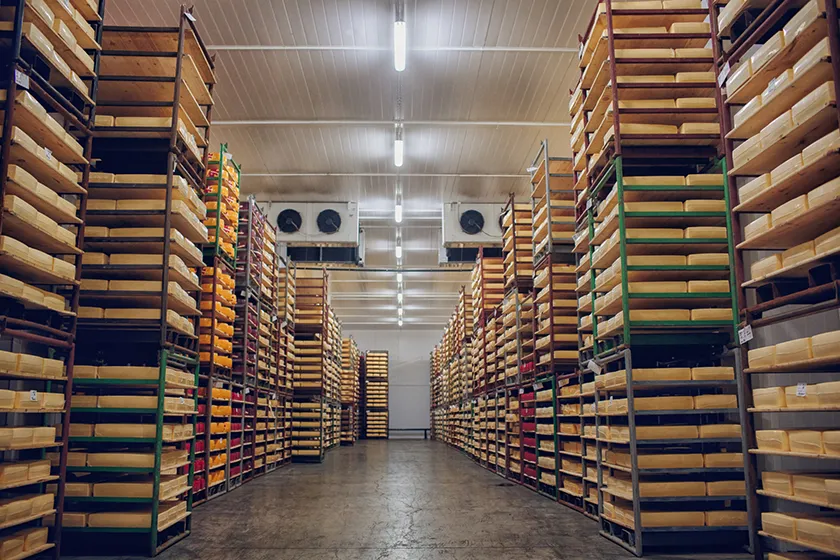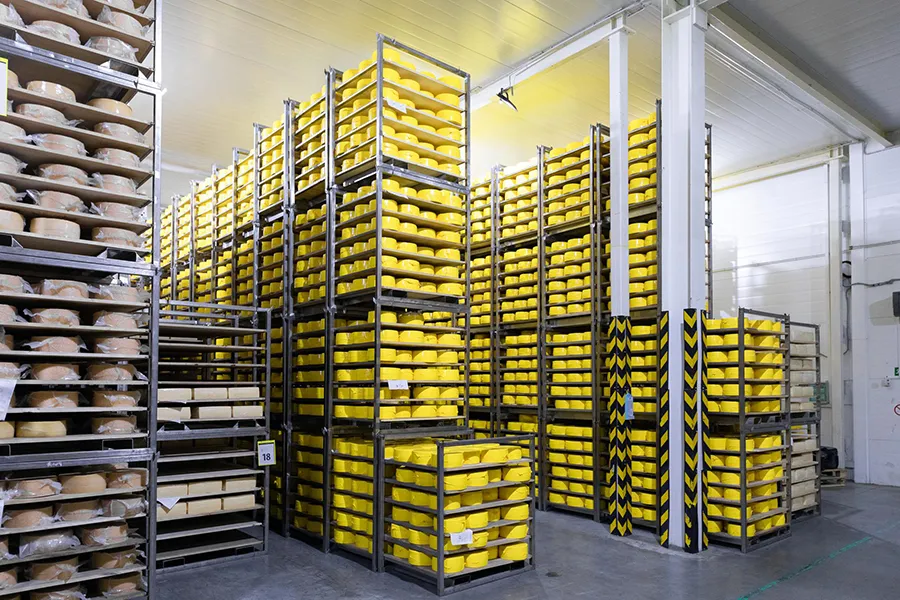Proper and principled food storage can prevent spoilage, contamination, and loss of food quality, and in addition to ensuring consumer health, it will also help reduce costs and increase operational efficiency. Given the diversity and sensitivity of food types, warehousing must be carried out in compliance with specific standards and principles to prevent health and safety problems. On the other hand, the use of modern technologies in this area can make warehousing processes smarter and increase its efficiency. In this article, in addition to examining the principles and standards of food warehousing, warehouse safety, etc., we have discussed some of the modern technologies used in food warehousing and their benefits.
What is food warehousing?
Food warehousing directly affects the maintenance of food quality, health, and safety, especially since many foods require specific storage conditions. Compliance with proper storage principles can prevent spoilage, contamination, loss of quality, and health problems. An important issue in warehousing services is compliance with safety standards and principles to maintain the quality and health of food. The following will discuss some key principles and points in food warehousing.

Food Storage Principles and Standards
Following the correct principles of storage, in addition to preventing spoilage or spoilage, contamination and waste of food, is effective in maintaining the health of consumers. Food storage requires observing a set of principles that help maintain the quality, safety and hygiene of food. By observing these principles, food spoilage can be prevented and food storage operations can be carried out effectively. The following are some important principles of food storage that are necessary and essential for food storage:
Control of temperature, humidity and light in the warehouse
Perishable foods such as meat, dairy products and vegetables should be stored at low temperatures and in the refrigerator or freezer. While dry materials such as rice, legumes and flour should be stored at room temperature. In food storage, humidity must also be controlled and maintained at an appropriate level to prevent the growth of fungi and bacteria. Maintaining controlled humidity is especially important for
cereals, dried fruits and spices. Light-sensitive foods should be stored in dark environments or in light-proof packaging to prevent the breakdown of nutrients and vitamins in them.

Use of FIFO (First In, First Out) System
The use of FIFO system is one of the important principles in food storage. This system means that food items entering the warehouse should be consumed first and foremost. This method is especially necessary for products that have an expiration date, and it causes older items to be consumed sooner and prevents spoilage and waste.
Warehouse Cleaning and Hygiene
Observing hygiene principles in food storage is of particular importance. Any contamination, pests and vermin such as insects, mice, etc. can cause food to spoil and spoil. For this reason, continuous cleaning of the warehouse and storage equipment, the use of traps, insecticides, pest control systems, etc. are essential for food storage. In addition, monitoring hygiene conditions and using disinfectants on the surfaces and floors of the warehouse is essential to prevent contamination and bacterial growth.
Warehouse Safety and Security
Safety in food storage is very important, especially against risks such as fire and theft. For this purpose, it is necessary to install alarm systems, surveillance cameras, safety locks and fire extinguishing systems in the warehouse. Also, safety equipment such as gloves and safety shoes should be used when moving goods. Warehouse staff should also receive the necessary training in the field of hygiene, safety and proper warehousing so that they can use their training in emergency situations.
Using modern technologies in food storage
The use of modern technologies in food storage not only helps improve efficiency and reduce costs, but also allows for optimal resource management, waste reduction, and quality assurance of food products. With the further advancement of technology, food storage has also moved towards becoming smarter and using more advanced automation systems to carry out warehousing operations with higher quality and speed. Below we have mentioned some of these technologies:
Internet of Things (IoT) technology in smart warehousing
The use of the Internet of Things (IoT) enables smart food storage and by installing various sensors, you are informed of any sudden changes in environmental conditions so that you can take the necessary measures to prevent food spoilage. Smart food storage is especially necessary and appropriate for temperature-sensitive products such as dairy products, meat, and vegetables.
Smart food storage also enables the detection of smoke and fire, the activation of sprinkler systems to extinguish fires, the use of smart locks, smart handles, smart lighting systems, and smart heating, cooling, and air conditioning systems.
Warehouse Management System WMS
One of the most advanced technologies in warehousing processes is Warehouse Management Systems (WMS). These software programs allow warehouse owners to easily and quickly obtain accurate information about the inventory of goods. Using these systems, it is possible to simulate the inventory status, the date of arrival and departure of goods, reduce costs, etc. at any time.
In addition to providing accurate and up-to-date reports, WMS warehouse management systems offer capabilities that increase productivity and reduce human errors. Other advantages of using WMS systems include:
- Quick and accurate inventory statistics for each product in the shortest possible time
- Tracking the location of the product without the need to be present in the warehouse
- Timely warning for products with a specific expiration date
- Reducing costs due to the reduction in the need for manpower in different stages of warehousing
- Better management and accuracy of warehouse inventory and information about the flow of entry and exit
- The ability to customize the software based on the demands and needs of the organization
- The ability to generate general and specialized reports in the required time intervals
- The ability to define different access levels for different users
- The ability to design management dashboards
- The ability to establish a system connection with other software available in the organization

Conclusion
In food warehousing, factors such as temperature control, humidity, cleanliness, use of FIFO systems, ensuring warehouse safety and security are of great importance and their observance will be effective in maintaining the quality of products in the warehouse. In addition, the use of new technologies such as the Internet of Things, warehouse management systems (WMS), etc. can bring warehousing processes to a new level of efficiency and accuracy. Proper and principled warehousing not only prevents food spoilage and waste, but also helps in maintaining consumer health and reducing costs over time.

